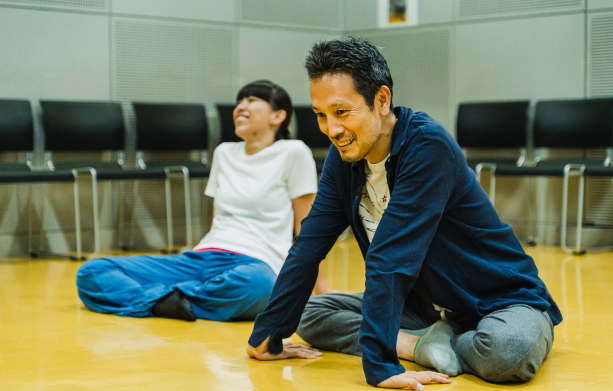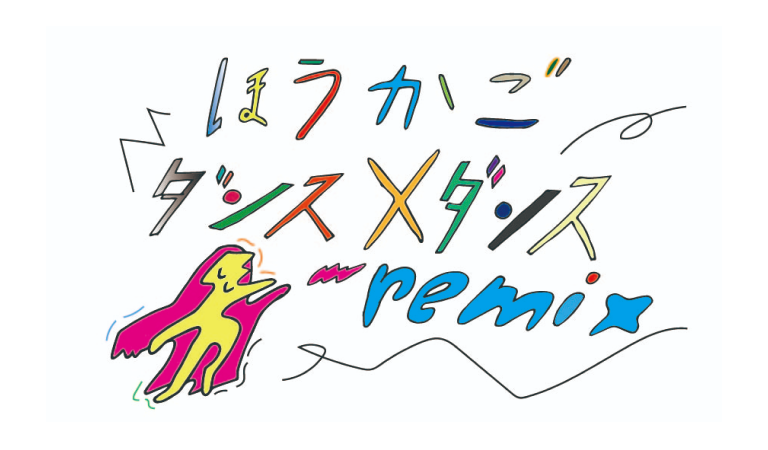Reflecting on the ADD Kunitachi City Project
"No Need to be a Professional to Tell the Very Basis of Dancing"
Osamu Jareo
Dispatched Dance Expert
Reina Kimura
Researcher, Choreography Assistant

――How do you feel, looking back at our sessions?
Osamu Jareo (OJ): We've been discussing the necessity in working with the community for this project since the beginning stages, and now I feel that it's come to fruition. I myself have been involved, by way of dance, with the special nursing home for the elderly in Maizuru, Kyoto for more than 10 years, and have also been involved with the locals in the areas affected by the Great East Japan Earthquake, and community activities in Shin-Nagata area, Kobe City, with NPO Dance Box. This time, being freshly moved out here to Kunitachi, I've built these relationships with the workshop participants and their parents over time, by seeing them not only in the sessions but also on streets. It's like my relationship with the community has gradually ripened. Thinking about dance has led me thinking about the relationships, environment, and networks that nurture and sustain dance cultures.
Reina Kimura (RK): I was also aware of the difficulty of this kind of project and the need for community involvement out of my past experiences. But since you actually live in Kunitachi, I was genuinely interested in observing how you interact with the locals (lol).
OJ: I think that was a great strategy, and I was able to relax when working on this (lol). Great teamwork!
RK: In Kunitachi, I feel like we were able to meet many unique people who take their own initiative in creating their own job. One person that stood out to me was Masami Kubota. I was so interested in learning about his life in Kunitachi over 35 years, and about this town where he has spent the time.
OJ: We've had many people join us as "experienced locals", and they all had strong personalities (Iol). They're not from the art world per se, but we've had unique individuals take part. To put it the other way around, I think we've been separating such people from our own context of "art", up to this point. Even Masami's speeches about human life...they may have been beyond understanding of the children, but even if they don't, at least they acknowledge that there are peculiar adults like him, and their experience of encountering those kinds of people would be an important part of "culture", I suppose. ADD was able to create a space that lets these children meet with lifestyles that they can't learn in schools.
RK: Because these peculiar people tend to be regarded as just suspicious in daily life context.
OJ: Kaori Saito, the person in charge of ADD at Kunitachi Community Arts Center, gave me the boost to create space like that. For instance, she was the one who told me that Yoko Ando, the mother of a workshop participant, was a saxophone player, and she ended up joining in the final showcase as a musician. Though she said she has little experience in improvisation performances, she looked like she had fun. I'm hoping to widen the network of people like this, and continue making something interesting happen in Kunitachi.

Masami Kubota's unpredictable actions intrigue the children.
――The challenges given by you when appointing someone as an "experienced local" was phenomenal. Like asking Suzuki sensei, a lacrosse player, to do a dance workshop, and even Maurice Morancie from Trinidad and Tobago.
OJ: I saw Maurice speaking to a negi (assistant to the chief of the shrine) when I went to go see shishimai (lion dance) at Yabo Tenmangu Shrine. It turned out he was from Trinidad and Tobago, and I was intrigued. When I asked what dances are there in his country, he told me about bélé, and so I asked if he could teach it to the children.
RK: Wow (lol).
OJ: He was like, "No, no. I can't possibly do that," and I told him, "It's going to be okay," and it led him to accept our invitation together with Zia Holder, who has great enthusiasm and knowledge in dancing, also from the same country.
RK: Even though they might not professionally teach dance, it's great to see everyone prepare themselves when asked to teach children. Especially when there are so many different art practitioners in town, it's important to look at these community members as "experienced locals". Minako Otake has a daytime job, but you can tell she's been practicing bon dance because she loves it so much. It makes me feel like you don't have to be a professional to teach the very basis of dancing. Of course it's important to experience learning the techniques from the professionals, but the joy of dancing, like on a lifestyle level, that dance underneath their skin, might be something to "experience together", rather than to "be taught". I feel like that's where we see the potential of the community.
――Like how the children were dancing with the instructors at the final showing.
OJ: For adults who don't have a particular specialization, there may not be much consciousness of hierarchy between the "teacher" and "student", when passing on to someone what you have received from someone else.


